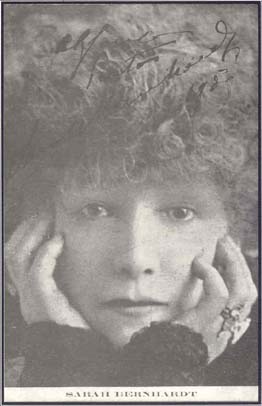1. SARAH BERNHARDT (Henriette Rosine Bernard; 1844-1923) Bilhete postal autografado com dedicatória (1905).
2. SARAH BERNHARDT em Theodora, de Sardou. Collection P.Nadar (Fot.1884). Ed. 1901.
3. SARAH BERNHARDT em Theodora. Bert, Paris (1902).
4. SARAH BERNHARDT em Angelo, de Victor Hugo. Clichê Manuel (Paris, 1905).
5. SARAH BERNHARDT.
6. SARAH BERNHARDT como Marie Antoinette em Varennes, de Henri Lavedan e Lenotre. Clichê Manuel (Paris, 1904).
7. SARAH BERNHARDT como Melissinde em La Princesse Lontaine, de Rostand. Fot. Reutlinger, Paris (1895) Ed. 1900.
8. SARAH BERNHARDT. Ed.A.Noyer, Paris (no. 161).
9. SARAH BERNHARDT. Ed.A.Noyer, Paris (no.44)
10. SARAH BERNHARDT em la Dame aux Camelias, de Dumas Filho.
11. SARAH BERNHARDT como Gismonda, de Sardou. Fot. Nadar (1894). Ed.1901.
12. SARAH BERNHARDT em Theodora. Fot.Nadar (1884) Ed. 1901.
13. SARAH BERNHARDT em Theodora. Fot.Nadar (1884) Ed. 1906).
14. SARAH BERNHARDT em Theroigne de Mericourt, de Hervieu. Fot.Boyer, Paris (1902).
15. SARAH BERNHARDT em La Samaritaine, de Rostand. Fot. 1897. Ed. 1901.

1
SARAH BERNHARDT
Eternizada
como a mais ilustre atriz francesa, Sarah Bernhardt conquistou as platéias
da Europa e das Américas, interpretando personagens. Em desempenhos
que a crítica consagrou para sempre, viveu A Dama das Camélias,
de Alexandre Dumas Filho, Dona Sol em Hernani, de Victor Hugo, Fedra,
de Racine e os papéis-títulos masculinos: Hamlet, de Shakespeare
e Lorenzaccio, de Musset, entre inúmeros outros.
Durante suas longas e
tumultuadas tournées ao Novo Mundo, Sarah Bernhardt apresentou-se
no Brasil em três temporadas. Na primeira, em junho de 1886, estreou
no Imperial Teatro São Pedro de Alcantara do Rio de Janeiro e apresentou-se,
também, nos Teatros São Jose, de São Paulo, e São
Carlos, de Campinas. Retornou em junho de 1893 e em outubro de 1905, ocupando
nessa derradeira visita o Teatro Politeama paulista e o Teatro Lírico
do Rio de Janeiro, onde no palco, segundo muitos, teria sofrido o acidente
que viria a ocasionar-lhe a amputação da perna direita em
1915.
Primeira intérprete
de Fedora (1882), Theodora (1884) e La Tosca (1887), de Victorien Sardou,
Sarah Bernhardt inspirou, também entre outros escritores Oscar
Wilde - que sonhava vê-la representar sua proibida Salomé
(1892) - e Edmond Rostand que criou expressamente para ela A Princesa
Longínqua (1895), A Samaritana (1897) e L' Aiglon (1900).
Profundamente dramática
e espetacular, Sarah Bernhardt atingiu tal prestígio que reinava
absoluta sob uma verdadeira corte pessoal:"Não sei quanto
tempo fiquei fascinada pelas letras do meu nome".
Nascida em 1844, Sarah
Bernhardt faleceu na própria Paris, em 26 de março de 1923.
SARAH BERNHARDT
Eternalized
as the most famous French actress, Sarah Bernhardt captured audiences
in Europe and the Americas. In performances that the critics forever acclaimed,
she played The Dame aux Camelias by Alexandre Dumas Son, Dona Sol, in
Hernani by Victor Hugo, Fedra, by Racine and in masculine parts, the title
role in: Hamlet, by Shakespeare nd Lorenzaccio by Musset, among several
others.
During the long and tumultuous
tours in the new world, Sarah Bernhardt played in Brazil during three
different seasons. On the first one, June 1886, she opened at the Imperial
São Pedro de Alcantara Theatre in Rio de Janeiro and also performed
at the São Jose Theatre in São Paulo and the São
Carlos in Campinas. She returned in June 1893 and in ther last tour in
South America, in October 1905, playing at the Politeama Theatre in SãoPaulo
and the Lyric Theatre in Rio, on which stage, according to rumours, she
suffered the accident that caused her to lose her right leg in 1915.
The first one to interpret
Fedora (1882), Theodora (1884), and La Tosca (1887) by Victorien Sardou,
Sarah Bernhardt also, among other writers, inspired Oscar Wilde - who
dreamed of watching her perform his forbidden play Salome (1892) - and
Edmond Rostand who wrote La Princesse Lontaine expressly for her (1895),
as well as La Samaritaine (1897) and L'Aiglon (1900).
A profoundly dramatic
and spectacular person, Sarah Bernhardt reached such prestige that she
absolutely reigned over a true personal court: "I don't know for
how long was I fascinated by the letters of my name".